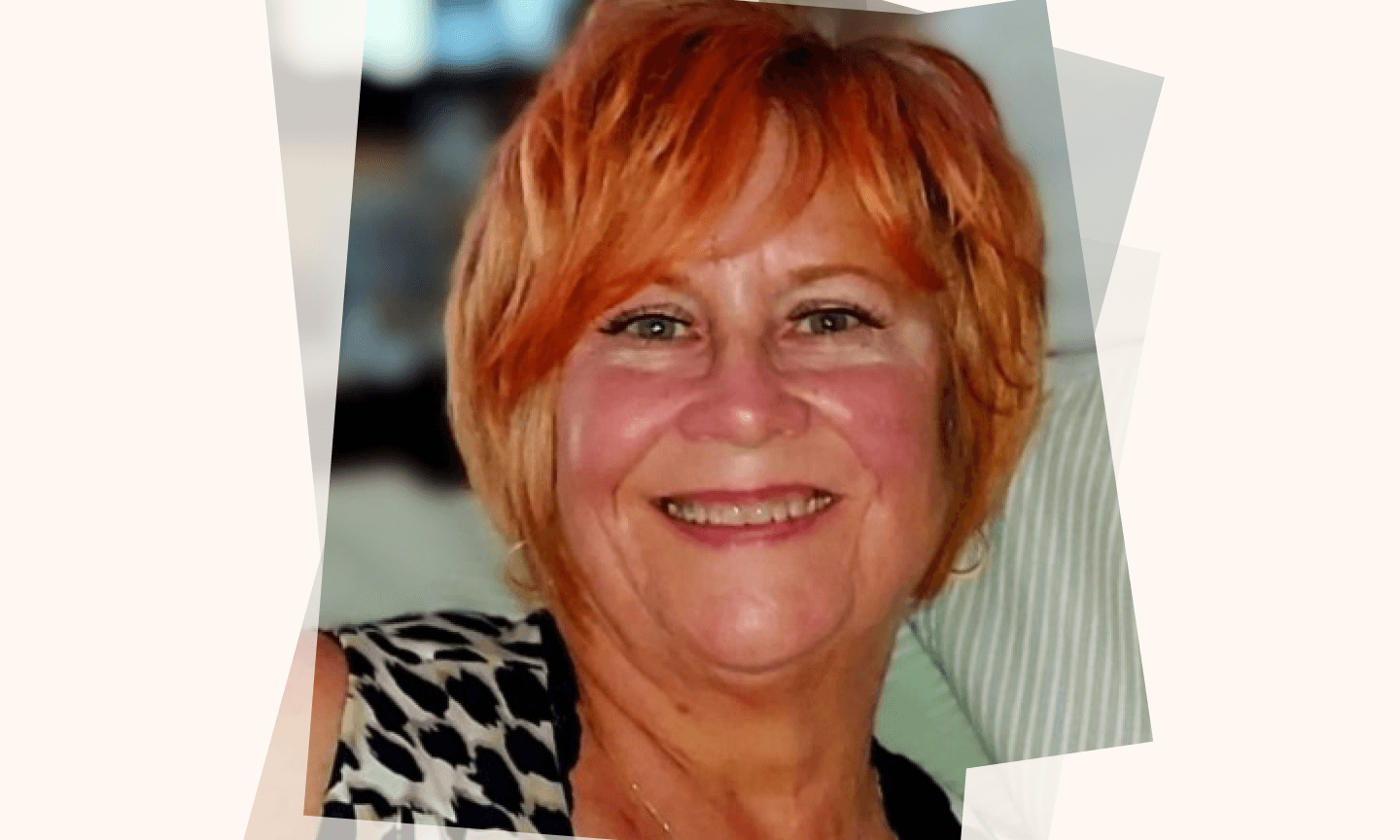During the COVID-19 pandemic, Peg worked as a nurse on the COVID unit at a rehabilitation facility. In December of 2020, she got the virus for the first time — something she’d seen many other people go through.
Then things took a turn.
It wasn’t until several doctor’s visits, multiple tests, and a lot of self-advocacy that Peg and her providers discovered she had something completely unrelated to COVID. Peg had ovarian cancer.
Psst…Peg is a contracted spokesperson for GSK. She shared her personal story about being diagnosed with ovarian cancer with us. This article reflects Peg’s experience, and others’ may be different.
How is ovarian cancer usually diagnosed?
About twenty thousand women in the United States are diagnosed with ovarian cancer every year. It can originate in the ovaries or fallopian tubes, and is most commonly diagnosed in women over 55 years old.
Aside from age, the most common risk factor for ovarian cancer is a family history of breast or ovarian cancer, which can be related to certain inherited gene mutations like the BRCA gene.
Unlike with some other cancers, there are no standard screening tests for it (nope, not even pap smears). Plus, many of the symptoms of ovarian cancer can be vague, often resembling other common conditions. We’re talking abdominal pain, bloating, urinary issues, fatigue, and changes in bowel movements.
In Peg’s case, she got “lucky” by finding her cancer another way. The morning after she tested positive for COVID, Peg had some rectal bleeding. She knew from her work experience that this could be serious, so she went straight to the ER. An abdominal CT scan, lab work, and X-rays showed nothing out of the ordinary apart from COVID-related pneumonia, and she was told the rectal bleeding was from colitis. So after a short hospital stay, she went home.
A month later, Peg noticed a dull sensation on the left side of her abdomen and went back to the ER — only to get another normal CT scan and, again, go home. Eventually, there was a third trip, and a third abdominal CT. This time, an ovarian cyst showed up. But even that didn’t ring alarm bells, and Peg was told to follow up with her gynecologist in three months.
What did Peg do next?
Here’s where Peg’s nursing background kicked into high gear. “Being the stubborn nurse that I am, I ignored the recommendation to delay scheduling and made an appointment to be seen in two days,” she says. “I was 65 years old! I didn’t think I should be developing cysts.”
After that visit, Peg’s gynecologist discussed her case with a gastrointestinal surgeon. Together, they concluded that Peg had developed an infection that extended to her ovary as a result of the colitis. So they then scheduled surgery for March 9, 2021, for a partial colectomy and to remove the ovary they believed was affected by infection.
On that day, Peg woke up in her hospital bed to find out that her doctors hadn’t actually performed the planned surgeries. Instead, her surgeon called in a gynecologic oncologist's opinion and took biopsies. It was during that procedure that her ovarian cancer was finally discovered — over three months after she first noticed something was off.
What happened after her ovarian cancer diagnosis?
Peg was shocked when she got the news. “Ovarian cancer?! I felt like I was sucker punched. Suddenly, it felt like the room was spinning.” As a result of the diagnosis, she was then scheduled to have a total hysterectomy (including both ovaries and fallopian tubes) and partial colectomy less than a week later. Needless to say, it was all happening fast, and Peg had a lot to cope with all at once.
Ovarian cancer treatment plans typically include surgery to remove any tumors. Depending on the type and stage of the cancer, oncologists may recommend radiation therapy or systemic treatments like chemotherapy, hormone therapy, or immunotherapy.
Once Peg had the surgery for her ovarian cancer — an intense, seven-hour ordeal, her oncologist suggested six rounds of platinum-based chemotherapy. Fortunately, she responded to chemo, and the next step for Peg was consulting her gynecologic oncologist to determine if a maintenance therapy would be right for her.
I’ve never heard of maintenance therapy. How does that work?
Unfortunately, 85% of women with advanced ovarian cancer experience a recurrence after initial treatment. “Watch and wait” was the standard practice in monitoring women after initial treatment for years, but now, physicians have options that work to delay or decrease the chances of the cancer returning or progressing.
Peg’s oncologist recommended ZEJULA (niraparib) tablets, a once-daily oral medication available in 100, 200, or 300 milligram (mg) strengths.
APPROVED USE
ZEJULA tablet is a prescription medicine used for the maintenance treatment of adults with advanced ovarian cancer, fallopian tube cancer, or primary peritoneal cancer. ZEJULA is used after the cancer has responded (complete or partial response) to treatment with platinum-based chemotherapy. It is not known if ZEJULA is safe and effective in children.
Maintenance therapy options, like ZEJULA, may help delay certain types of advanced ovarian cancer from coming back.
Peg and her oncologist went over the potential side effects of ZEJULA. That included the more serious side effects like bone marrow problems called MDS (myelodysplastic syndrome) and a type of blood cancer called AML (acute myeloid leukemia) which may lead to death. ZEJULA has also been associated with high blood pressure and PRES (posterior reversible encephalopathy syndrome), which may cause headaches, vision changes, confusion, or seizures. These are not all the potential side effects of ZEJULA; please review the Important Safety Information below, as well as the full Prescribing information, for more.
Peg proceeded with treatment of 200mg of ZEJULA. She and her oncologist stayed on top of the routine monitoring of blood pressure, heart rate and blood counts that are required while on ZEJULA. At one point, Peg’s blood pressure was elevated, and she was sent to her oncology cardiologist for medication adjustment. Her blood pressure was stabilized. However, because her platelet count was consistently dropping, her oncologist adjusted her ZEJULA dose to 100mg, which she’s tolerated well. Again, this was Peg’s experience, and others’ may be different.
What’s Peg’s life like now?
Peg takes ZEJULA every night before bed. She continues to have her blood work monitored monthly, and she sees her oncologist regularly, which she says is key. “I am grateful for the relationship I have with her,” Peg notes. Finding a doctor who she felt confident communicating openly with was critical for Peg. “The stubborn nurse in me was reluctant to take on the patient role…but putting full trust in her was the best decision I could have ever made,” she says.
While some fear remains, Peg copes with her condition by keeping herself busy with baking, walking, and regular trips to the gym. “My husband and I like to spend time with our friends and family as much as possible,” she says.

theSkimm
Due to vague symptoms and no standard screening tests, ovarian cancer can hide in plain sight. Peg’s story is unique, but there’s a universal truth to be learned from it: Especially as a woman, it’s crucial to advocate for your own health. Listen to your body, trust your instincts, and talk to your doctor when something doesn’t feel right. They can help you determine what treatments might be right for you.
Psst...see below for Important Safety Information about ZEJULA.
Important Safety Information for ZEJULA
ZEJULA may cause serious side effects, including:
Bone marrow problems called Myelodysplastic Syndrome (MDS) or a type of blood cancer called Acute Myeloid Leukemia (AML). Some people who have ovarian cancer and who have received previous treatment with chemotherapy or certain other medicines for their cancer have developed MDS or AML during treatment with ZEJULA. MDS or AML may lead to death.
Symptoms of low blood cell counts (low red blood cells, low white blood cells, and low platelets) are common during treatment with ZEJULA. They can be a sign of serious bone marrow problems, including MDS or AML. These symptoms may include the following:
Weakness
Feeling tired
Weight loss
Frequent infections
Fever
Shortness of breath
Blood in urine or stool
Bruising or bleeding more easily
Your doctor will do blood tests to check your blood cell counts before treatment with ZEJULA. You will be tested weekly for the first month of treatment with ZEJULA, monthly for the next 11 months of treatment, and as needed afterward.
High blood pressure is common during treatment with ZEJULA, and it can become serious. Your doctor will check your blood pressure and heart rate at least weekly for the first two months, then monthly for the first year, and as needed thereafter during your treatment with ZEJULA.
Posterior reversible encephalopathy syndrome (PRES) is a condition that affects the brain and may happen during treatment with ZEJULA. If you have headache, vision changes, confusion, or seizure, with or without high blood pressure, please contact your doctor.
Before starting to take ZEJULA, tell your doctor about all of your medical conditions, including if you:
Have heart problems
Have liver problems
Have high blood pressure
Are pregnant or plan to become pregnant. ZEJULA can harm an unborn baby and may cause loss of pregnancy (miscarriage)
If you are able to become pregnant, you should use effective birth control (contraception) during treatment with ZEJULA and for 6 months after taking the last dose of ZEJULA
If you are able to become pregnant, your doctor should perform a pregnancy test before you start treatment with ZEJULA
You should tell your doctor right away if you become pregnant
Are breastfeeding or plan to breastfeed
ZEJULA may harm your baby. You should not breastfeed your baby during treatment with ZEJULA and for 1 month after taking the last dose of ZEJULA
Tell your doctor about all the medicines you take, including prescription and over-the-counter medicines, vitamins, and herbal supplements.
The most common side effects of ZEJULA include the following:
Nausea
Tiredness
Constipation
Pain in your muscles and back
Pain in the stomach area
Vomiting
Loss of appetite
Trouble sleeping
Headache
Shortness of breath
Rash
Diarrhea
Cough
Dizziness
Changes in the amount or color of your urine
Urinary tract infection
Low levels of magnesium in the blood
If you have certain side effects, then your doctor may change your dose of ZEJULA, temporarily stop, or permanently stop treatment with ZEJULA.
These are not all the possible side effects of ZEJULA. For more information, ask your doctor or pharmacist. Call your doctor for medical advice about side effects. You are encouraged to report side effects of prescription drugs to the FDA. Visit www.fda.gov/medwatch, or call 1-800-FDA-1088.
Click here to view the full Prescribing Information for ZEJULA tablets.
Trademarks are owned by or licensed to the GSK group of companies.
©2024 GSK or licensor.
PMUS-NRPCOCO240001 July 2024
Produced in USA.
Subscribe to Skimm Well
Sign up here to receive our wellness newsletter filled with actionable advice, expert-vetted content, product recs, and more — delivered directly to your inbox.
